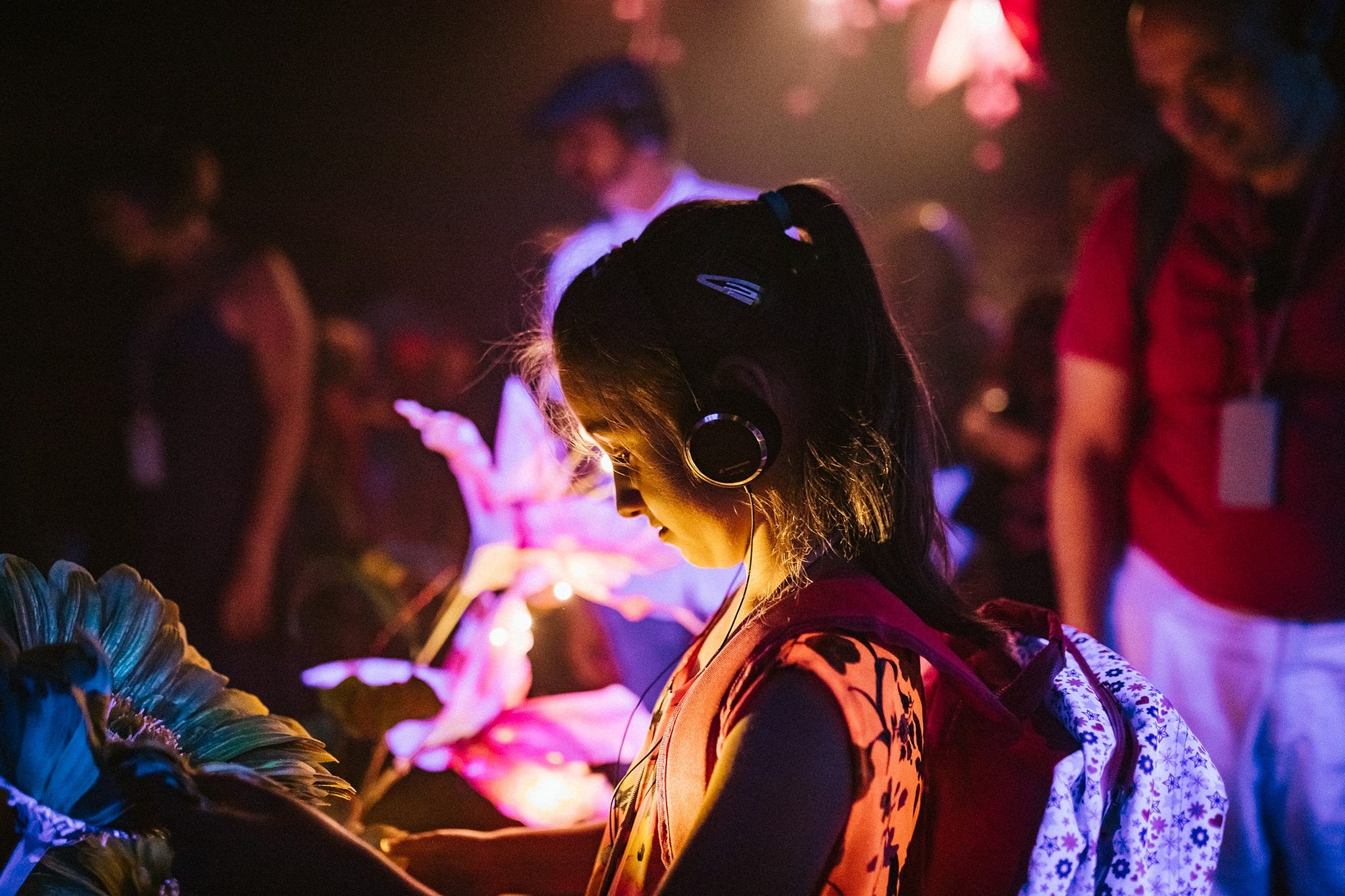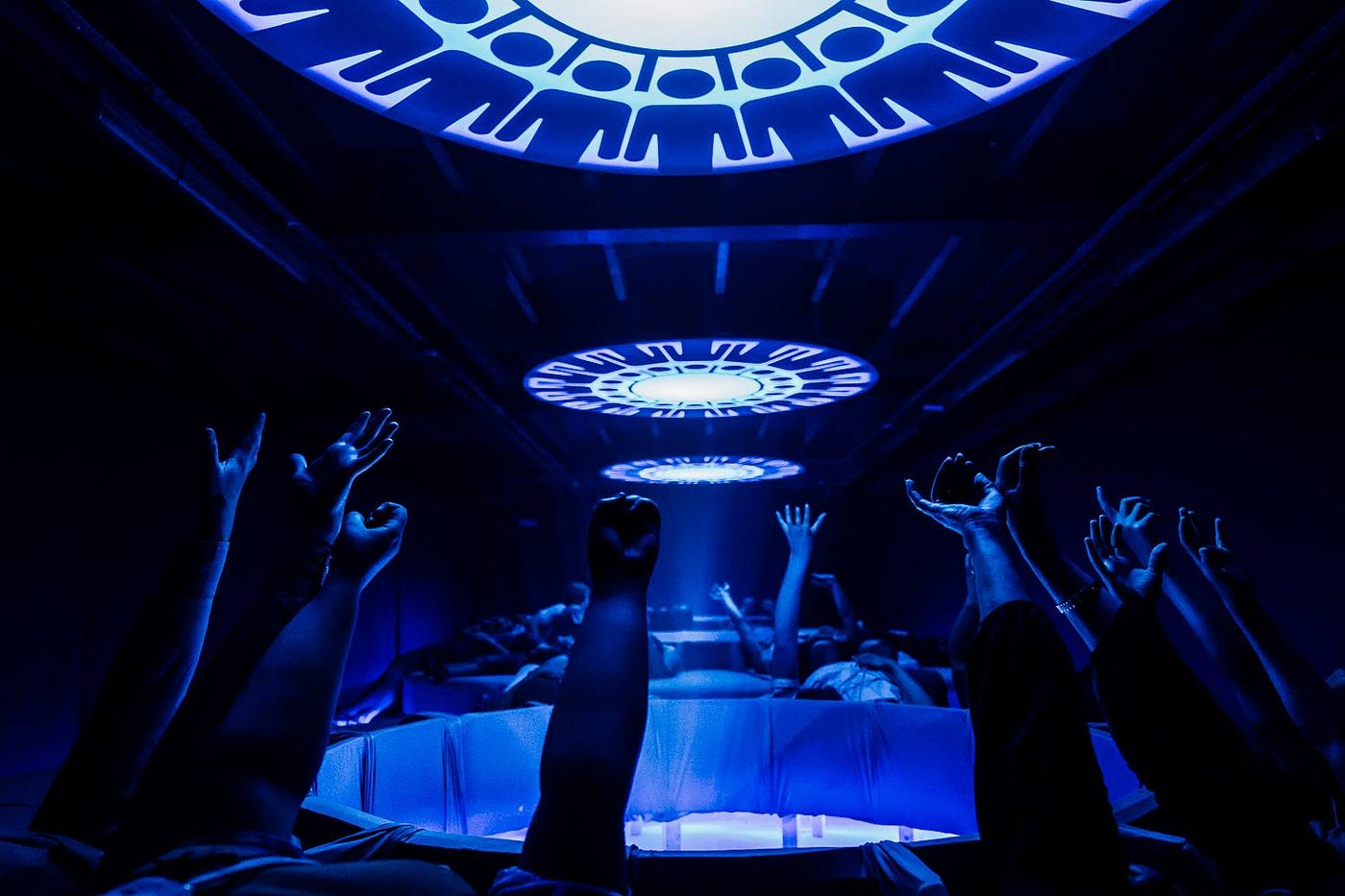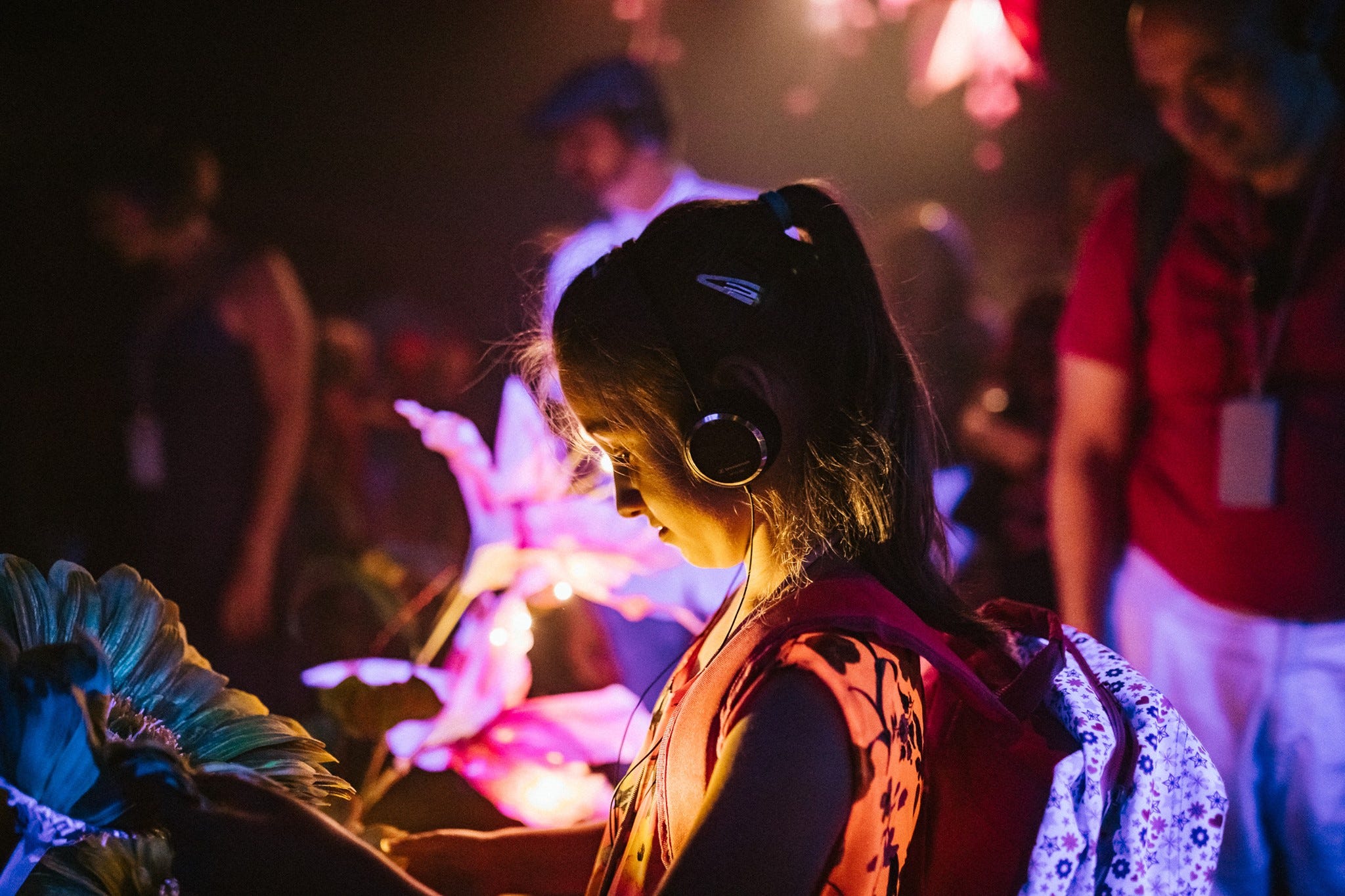
Disney’s Fantasia comes to life at The Vaults in London
As a music teacher, devoted immersive attendee, and long-time Disney fan, I was very excited to visit the latest offering from The Vaults in London: Sounds and Sorcery, celebrating Disney’s Fantasia. This experience was a true family affair, as coming alongside me were my mum, dad, and brother.
We made our way through a dark corridor with stars twinkling above us and approached a white, sterile Westworld-style waiting room. One by one, we were handed devices attached to lanyards and headphones. Our group was assigned a color and once the room lit up in our color, we took our cue to enter.

Headphones in place, we were guided through into a dark room and asked to sit on large donut-shaped couches, with at least a dozen people on each one. Soft, tantalizing voices began to materialize in our ears, welcoming us to the experience. The familiar sound of an oboe cued the rest of the orchestra to begin tuning. Instinctively, as my musician’s auto-pilot kicked in, and I found myself breathing deeper, cracking my neck back and forth eager for the performance to begin.
As the orchestra warmed up, we lie down, facing a large circular screen on the ceiling. The first strains of Bach’s famous “Toccata and Fugue” began to play, and the room went dark. Projections of spinning musical instruments and glittering colors appeared above us, like a giant kaleidoscope that inviting us to dive further and further into its dazzling display.
A kaleidoscope is the best analogy for Sounds and Sorcery. Almost every piece from the original 1941 film has an entire set dedicated to it. Each individual space invites you to delve into the music and let yourself be absorbed into its world, at your own pace and in your own time. As you move from room to room, your headphones automatically sync up with the room’s design: lighting, projections, and other special effects.

“The Rite of Spring” room featured an active volcano in the middle of the room. The soundtrack runs on a 20-minute loop to match the lighting and effects of the magnificent prehistoric space. No part of the room was considered “off limits,” so be sure to mind your head in the pitch black caves and watch your footing as you step over the uneven ground. And if you go far enough, you may find a remnant of the previous rulers of this land. Meanwhile, the incredible sounds of Stravinsky’s riotous masterpiece pound through your head, body and feet, thanks to hidden subwoofers which emphasize every twist and turn in the score. As lightning flashed around me, I found myself climbing over what appeared to be a deep and terrifying gorge (it later turns out to be filled with foam rocks). Soon after, in a moment of quiet, greenery appeared on the now dormant volcano, and a trickling river began to flow from the peak of the mountain.

Two of the spaces, “The Dance of the Hours” and the famous “Sorcerer’s Apprentice,” both feature live performances. In the former, four dancers take on the roles of Hyacinth Hippo, Ben Ali (an alligator), Elephanchine (an elephant) and Madame Upanova (an ostrich). The four compete for the audience’s love and affection by showcasing their skills, including a most impressive aerial display. In this rowdy but good-natured race, they push and pull at each other to get to the end of a raised platform, so that one of them might be crowned victorious. In contrast to this light-hearted competition, “The Sorcerer’s Apprentice” places us in a dark and damp medieval castle where three servants are doing the bidding of their mistress, a mysterious sorceress before they try to find magical shortcuts to their work. Just as the performers do, Dukas’ score dances around us what at first seemed an easy solution turns into utter chaos, with every audience member being forced to soak in the experience.
Get Edward Mylechreest’s stories in your inbox
Join Medium for free to get updates from this writer.
SubscribeSubscribe
A final room showcases the nightmare-inducing “Night on Bare Mountain” which transitions into the stunning choral piece “Ave Maria.” The final piece is the only example of choral singing (or any human voice, for that matter) since the very beginning of the whole experience, which enters into our headphones as we exit through this final space.

Stepping out into the sunlight I find myself in a state of bliss.
But not all who have visited Sounds and Sorcery have left in such a state, and there has been quite a backlash to the piece online, especially around lack of narrative or a sense of cohesion between the rooms. While this is true, the experience was quintessentially Fantasia for me. In the film, each piece of music has its own visual interpretation, but not necessarily a story; this real-life interpretation of the film gives each piece its own internal world to explore, and each world stands alone. Devotees of the film will quickly recognize this and many Easter eggs in the set design. But for those unfamiliar with the source material, the link between the music and the set might not seem exactly clear.
Sounds and Sorcery is a site-specific art installation which gives the audience complete agency to discover. Expecting a Drowned Man or Secret Cinema production will not yield the desired results, but the creators also have not advertised themselves as such. Additionally, if you are coming into the space expecting to see Mickey Mouse plastered everywhere, I’m afraid you will be disappointed as well.

After all, when the original film was first released in 1941, many criticized it for being too scary or unsuitable for children; but decades later, thousands of children across the world can pinpoint Fantasia as being the starting point of a journey into classical music. I was reminded of this while in one of the rooms of the “Nutcracker Suite” set, a collection of five individual rooms each showcasing one of Tchaikovsky’s short pieces.
I sat in an enclave overlooking a frozen lake, as the music of the famous “Waltz of the Flowers” played around me. During a brief lull, there was no particular visual spectacle to view. It was during this brief pause that other visitors came into the room. A small child began toddling all over the frozen lake, ready to explore and listen, while two adults walked around looking at the trees, preoccupied with the physical set of the space. As famous introduction to the waltz with the exquisite harp glissandi played, as I sat and observed them. And that was enough for the two grown-ups. They had been in the room, they had heard the music, and so they left. If only they had stayed an extra ten seconds, they would have seen the room come alive with perfectly synchronized lights, as the lake itself danced along to the music. But the child’s face lit up and she performed her own pas de deux with the lake, with not a care in the world. What better an introduction to classical music than this? I thought.
Sounds and Sorcery invites the audience to be immersed within classical music. For those who are willing to take the time, this piece more than succeeds at this. This is not a piece to be rushed through; it is to be absorbed slowly and thoughtfully. If only the adults I observed had been willing to allow more of a sense of wonder in their exploration, then the room would have fulfilled it.
But for me, exploring this immersive installation was like revisiting an old friend and mentor. I was reminded that my fire for classical music that had been ignited all those years ago by an unconventional, divisive animated film. I can only hope that more people allow this unconventional space to do the same.
Sounds and Sorcery continues through September 30. Tickets are £23.50–43.
NoPro is a labor of love made possible by:

…and our generous Patreon backers: join them today!
In addition to the No Proscenium web site, our podcast, and our newsletters, you can find NoPro on Twitter, Facebook, YouTube, Instagram, in the Facebook community Everything Immersive, and on our Slack forum.




















Discussion